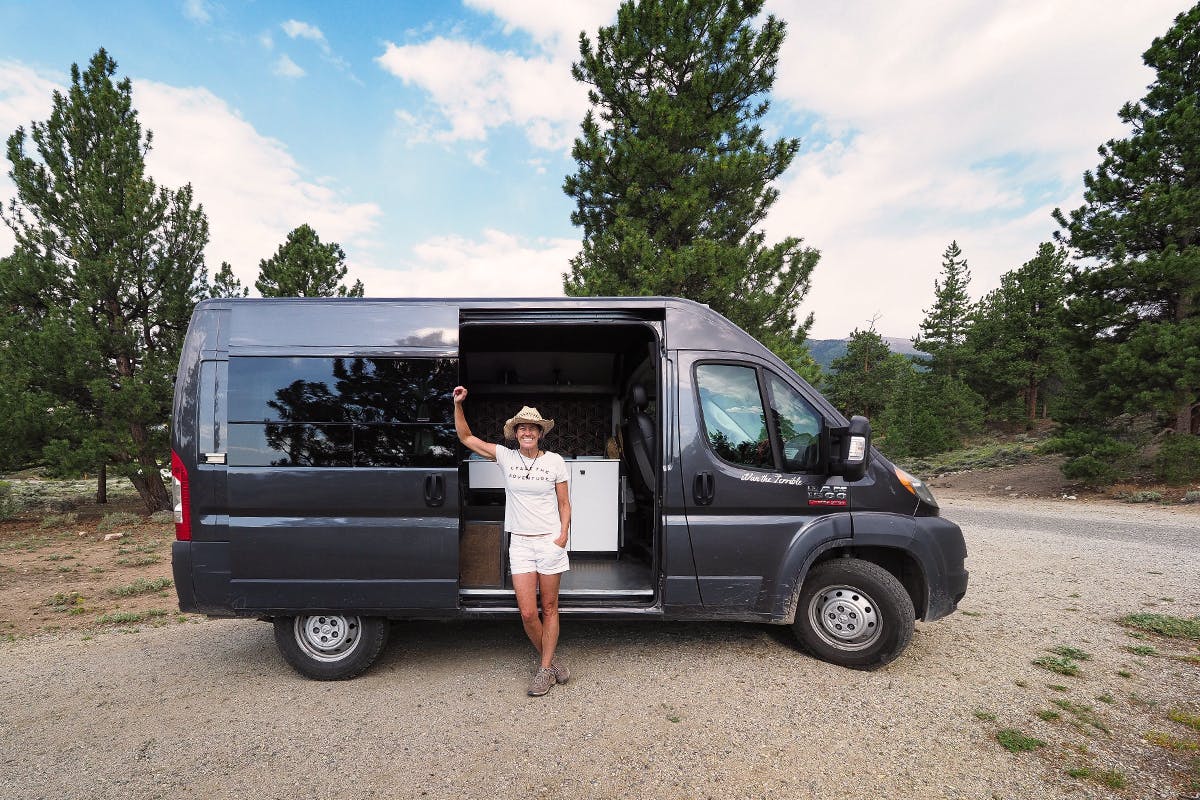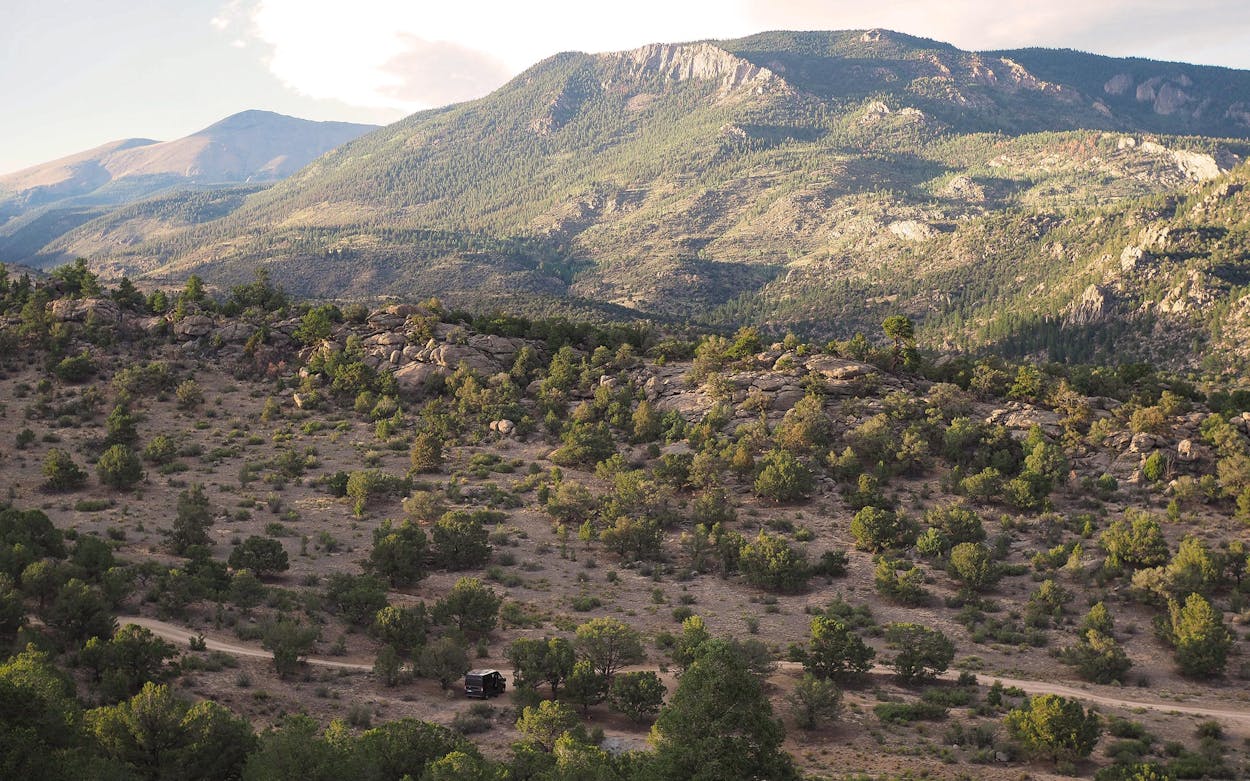A copy of Van Life: Your Home on the Road lives on my bookshelf, its pages filled with photographs of stylish vehicles. Glossy photos show seventies-era Volkswagen Westfalias with pop-up sleeping hatches; formerly dilapidated old school buses customized with miniature kitchens and sofas; and other custom builds, often with a surfboard, kayak, or bicycle in tow.
I slid the book off its shelf a few months ago, not long after COVID-19 forced us all to rethink how we were going to travel, and started fantasizing about a socially distant camper-van tour of Colorado—my own version of van life, minus the flowy hair and floral dresses. We would find wide-open spaces, and camp in forests and orchards instead of booking hotels. We’d go rafting and hiking, and cook meals on the stove in our van instead of eating at restaurants. As it turns out, I wasn’t the only one with that idea.
“People want movement, they want to travel, and they need to go see family members, but candidly, people are nervous about mass market airlines and mass market hotels,” says Jeff Cavins, cofounder and CEO of the Austin-based Outdoorsy.com, a website for RV and camper rentals. Bookings through the company spiked a whopping 4,500 percent between late March, when people began canceling other travel plans, and mid-June, when half the state of Texas apparently loaded up for a road trip to someplace cooler.
This isn’t an entirely new trend. In 2017, Texas sold more RVs—$424 million worth of them—than every state but California. The pandemic appears to have only boosted those numbers. Mike Regan, who owns two RV dealerships in Austin, told Bloomberg that his sales have been “through the roof.”
According to Kampgrounds of America’s North American Camping Report, travelers view camping as the safest type of getaway right now, over staying at hotels, with friends or relatives, or even shacking up at an off-the-grid cabin. And Kevin Long, cofounder of The Dyrt, a popular camping website and campground database, says traffic to the site jumped from about 15 million last year to more than 20 million now. “A lot of the jump started because of COVID, but we don’t see this trend going anywhere,” Long says.
For our camper van adventure last month, my husband and I picked up “Ivan the Terrible,” a customized Dodge Ram ProMaster 1500 outfitted with a mini-fridge, a two-burner stovetop, a sink with a seven-gallon container of water, interior lights powered by a rooftop solar panel, and a bed that sleeps two, at a place called Native Campervans in Denver. Ivan didn’t have a toilet or shower, but we could do without those. Then we headed into the mountains.
Because nearly 40 percent of the land in Colorado—more than 26 million acres—is publicly owned, we knew we’d find ample room to park our rig, even if official campgrounds were full. “Dispersed camping,” or camping outside a designated campground, is legal in national forests across Colorado. By contrast, only about 2 percent, or roughly 3 million acres, of land in Texas is publicly owned.
We aimed first for the Fourmile Recreation Area, a 100,000-acre wilderness expanse near Buena Vista, where we drove Ivan down a bumpy gravel road and parked in a pine-dotted canyon. We couldn’t see any other humans. We hiked up on a ridge and soaked in the wilderness, happy for the need to zip up our puffy jackets. Then we set up folding chairs, pulled out crackers and cheese, and listened to the silence before retreating to our mobile living quarters. I love sleeping in a tent, but snoozing in a cozy nook in the back of Ivan ranked pretty dang close. Plus, we didn’t have to drive any stakes or unroll a sleeping bag. We’d brought a tiny bedroom with us—one that had rear hatch doors that swung open to the great outdoors.

Over the next week, we got to know Ivan better. Our relationship hit a few rocks, it’s true. The key cylinder stuck at one point and needed a squirt of WD-40. We got caught in a storm at the top of a pass and a dime-size hailstone cracked the windshield. We learned that anyone taller than five-foot-eight had to curl slightly to fit in the snug sleeping bunk. And I couldn’t shake the feeling, sitting high in the shotgun seat as Chris piloted the vehicle, that I was flying through the air on an old-school chair swing ride at the carnival.
But we fell into a comfortable groove, and Ivan delivered us to adventure after adventure. We rafted Browns Canyon, bucking our way down the Arkansas River between red- and yellow-streaked canyon walls. We parked Ivan between rows of Pink Lady and Golden Delicious apple trees at an orchard in Paonia, where we listened to live music and swung like apes from tree swings. We avoided the crowds of the south rim and instead visited the more desolate north rim of Black Canyon of the Gunnison National Park, peering 2,200 feet nearly straight down into the steepest, sheerest gorge I’ve ever seen.
For our last hurrah, we drove Ivan over Independence Pass, between Aspen and Twin Lakes, where rigs longer than 35 feet are banned and the road narrows so much in two spots that only one vehicle can pass at a time. We met oncoming cars in both, and had to fold in Ivan’s side mirrors to squeeze past. When we made it safely down to a campground at Twin Lakes, we popped a celebratory bottle of wine and toasted Ivan for carrying us safely around the state.
Richard and Sandra Heath of Austin had plenty to celebrate on their recent pop-up camper tour of Texas and Colorado. It served as a honeymoon after the pandemic foiled their plans to get married on a glacier in Alaska. Instead, they held a small ceremony in their backyard, then headed out for ten days on the road in August. High winds ripped the awning off their camper one night, and they endured ovenlike temperatures at Palo Duro Canyon State Park—but they savored the 360-degree views from their screened-in pop-up, which has its own toilet and shower. “Being secluded and being able to sit out in nature makes me happy,” Sandra says. “It’s healing.”
The pandemic, Richard notes, has made it tougher to find a place to park their camper. “Everybody went out and bought an RV, and now you can’t find any place to go,” he says.
That just depends on what you’ve got in mind. John T. Baker, owner of Austin East KOA and president of Texas KOA Owners Association, says campgrounds and RV parks near Texas’s state and national parks, at the coast, or on lakes are thriving, while those near urban areas are seeing less business. “The big takeaway is a positive thing,” Baker says. “Vast swathes of folks across the country are discovering or rediscovering camping in all shapes or forms.”
As weather cools off, destinations like Martin Dies Jr. State Park in East Texas, Palo Duro Canyon in North Texas, and the Big Bend region of West Texas all look increasingly tempting, as do parks along rivers and lakes around the state.
“We have seen high demand for RV spaces at our parks,” says Margo Richards, vice president of community resources at the Lower Colorado River Authority. “Guests are telling us they are enjoying being able to work remotely and even have their children participate in online learning from their campsites. Plus, when you’re in a park, you get a little nature-based education every time you step out the door.”
In my week on the road, I learned a lot about camping in a van, besides, you know, that it’s a bad idea to fry chicken and brew coffee on the stove while rolling down the highway. (I didn’t actually try this, though I was tempted.) Most RV travel isn’t nearly as glamorous as #vanlife Instagram influencers make it look, especially without a built-in bathroom. It does, however, allow for maximum flexibility. You can change your plans and reroute your movable house on the fly, which comes in handy when you’re on a mission to avoid humanity. It’s also a reminder that you don’t always need fancy hotels or fine restaurants—a flat smooth patch of dirt will do just fine. That way, you can focus on the people you’re with, the trees outside that open back hatch, the breeze, and the raccoons that might trot through camp. And in times like these, that’s plenty.
Tips for first-time RV campers:
-
Practice backing up and parking your camper or RV.
Handling such a large vehicle can take some getting used to, so you’ll want to get comfortable behind the wheel before starting your trip. -
Make sure you know how to use the RV’s systems.
Try out the heater, stove, sink, and toilet (if equipped) prior to heading out. -
Download a camping app or two.
A few good options are Recreation.gov, The Dyrt, Hipcamp, Reserve America, and AllStays. These can be especially useful if your plans change and you need to find a last-minute spot. -
Find a campsite before dark.
It’s so much easier to get acclimated and find your way around without a headlamp. -
Bring a good toolkit.
Vans can break down (and larger RVs are especially prone to problems), so you’ll want to be equipped with a screwdriver, hammer, duct tape, and other essentials. -
Be responsible when camping outside of designated areas.
Don’t park your van within 100 feet of a water source, do stay within 150 feet of roadways to lessen the environmental impact, and look for a spot with fire rings, which indicate others have camped at your site previously.






